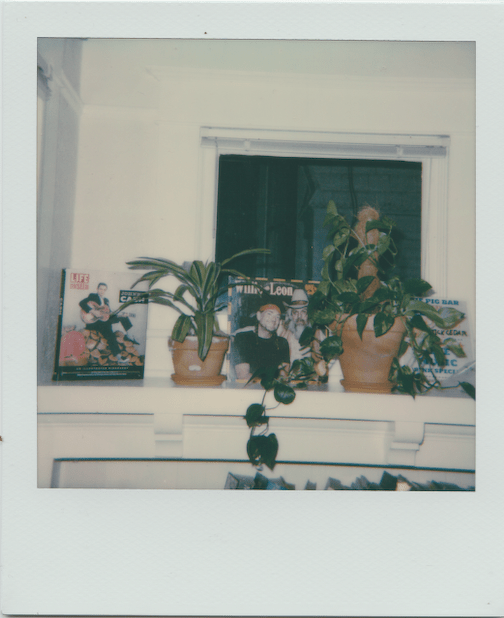Meet Laither, a frontman hopped up on harmony and tequila. He’s a nickname, an idea. King of camelia. Sings about eyesores and sultry vices, makes a guitar scream all nice. Conjured an album of noise and echoes, hidden wavers, and singing ghosts.

Meet Hutch Hartford. He’s sailing on a sea of sorrow and liquor, hotblooded and mending. Wearing a pearl snap and strumming precious. Made an album of the southwest. of marmalade & hickory. small towns. tar and forehead sweat. evaporation. charged fragments and real warnings.

Meet my dear friend, Laith Scherer. He’s the most dedicated musician I know. And here we are, in his living room, talking about art as possession. Creation as haunting, obsession, or frenzy in some way.

Laither and Hutch are just two of the many musical identities I’ve seen Laith inhabit over the years.[1] Witnessed phases or ideas that he let consume him. Or at least sink their teeth in. This double album is that consumption on display. Projects as possessions. Artisthood as generative curse. Album as artifact.
Laith explains it like this: “I’ve been obsessed with that idea—what is the guiding factor in your own conscious being that creates and writes songs. and I don’t think its decision-based. I think there is some sort of takeover. You have to be willing and ready to write and a song. and the song is, like, already there.”
The song that is and has been there, is: “Tucumcari, NM” the track that, for me, acts as the bridge between the two albums. This song I’ve seen played in a living room, a fourth-of-july backyard, a college common area, colonel summers park, two beautiful basements—holdovers from the Portland house-show scene—and that’s not to mention dancing to it at all the best venues in town. It’s a song of personal mythology, of transition and awakening. But to me, it does this reckoning while still just feeling good. I would even call it anthemic. Dwelling in that difficult to achieve liminal space where triumph meets unrest.
In the realm of crossover between the two albums, there is route 66, the blue swallow inn. There is also a fierce ideology: songs that waver between genre, work that exists in favor of fluidity.
Laith and I discuss the death of genre often, and the fecundity that could come from its grave. However, he is also cautious about sounding too harsh or absolute around this idea. I am less concerned with coming across as radical. So, let me be the one to suggest that we lay it to rest.
It may sound violent, but I believe it is actually an act of great compassion to disbelieve and dismantle genre. There is so much messaging which enforces the primacy of categorization and labeling as a helpful tool for sharing or understanding artwork. Instead, this has morphed into a harmful fable that works against equity, inclusion, and accommodating the highly subjective nature of art.
Individually, letting ourselves loosen grip on genre shows compassion to the creative self, allows us to circumnavigate the clumsiness that comes from trying to emulate some sterile or established aesthetic and stick to it arbitrarily. One genre or method may not even be enough to contain or represent the consciousness creating the work, let alone its rogue invaders, so why confine it in that way? And collectively, a rejection of genre is the rejection of a system handed down by the hegemony and the declaration of striving for a new one. Musically and otherwise.
Though he may not be describing it in such conceptual language, this is the same post-genre work that Laith is doing musically, allowing himself to sincerely engage in multiple sounds that all hold pull or interest. If you hear “country” in this music, try not to scoff, it’s really not ironic. Listen in a little further and you’ll hear spoken word, sermon. Elements of psalm and dirge. Ditty and hymn.
Both Hutch and Laither acknowledge this need for plural meaning, sourcing, and identity in their lyrics:
In Hutch’s “Song for Levon”
“I can be two people at once / I’ve already proved it”
And Laither’s “Nite Rites”
“got a creature of habit / and I feed it whatever it likes”
The terrain that is covered in these records is rocky and wide, with space for sonic wandering. Sometimes what seems like three or four songs twist into one and the seams between each are subtle, seeping.
Let me suggest continuousness. That these songs should be consumed as an experience, a unit. To make a case for listening to the album all the way through. Press play and give your curation brain a 22-minute break. Better yet, make it an hour, and hear them both.[2] Perhaps even pour yourself a drink or close your eyes while listening. Taste a takeover.
Laith is someone who is not afraid of being possessed. Who can sing in both church and tavern. His band is a whiskey spirit humming, a tecate demon, squeezing lime in your eye. A bass phantom. They cast their boozy spells and play. Miller high life spilled on the stage, pouring out for our mutual specters.
Amen.
& Catch Hutch on tour:

[1] i’m talking high-school jazz band star, musical theater lead, crooner, producer, sound guy, stalwart band member, and full-on-rockstar
[2] Both albums are available via both Spotify & Bandcamp, but when consuming, please consider each platform’s impact on independent musicians and the tenuous threshold for getting artists paid. thanks!
